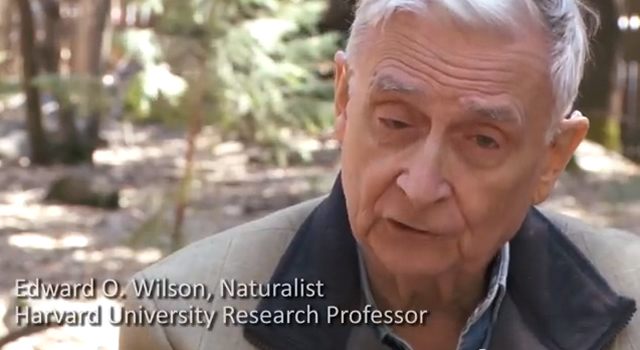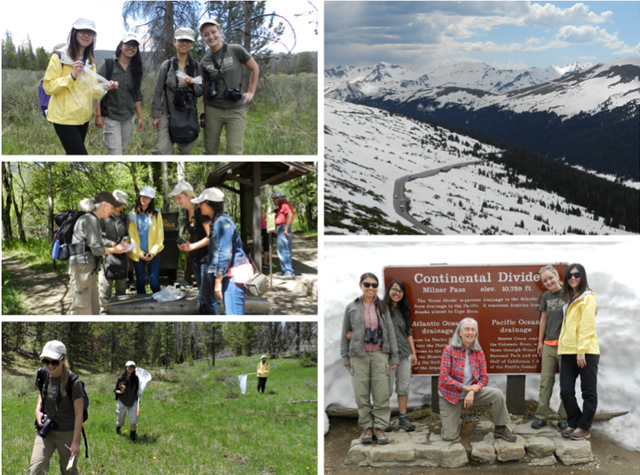Update: Watch E.O. Wilson’s keynote address, “Mission of the National Park Service and Its Relevancy Today”
Berkeley — The University of California, Berkeley, in partnership with the National Park Service and the National Geographic Society, look toward the 2016 National Park Service centennial with “Science for Parks, Parks for Science: The Next Century,” a summit initiating the science emphasis of the parks celebration. KQED is a media partner and Save the Redwoods is a key sponsor.
The conference takes place March 25–27 on the Berkeley campus exactly a century after an historic conference at Cal brought together scientists, conservationists and park leaders to focus on the need for a federal agency to manage park science, stewardship and public engagement. The March 1915 gathering catalyzed the formation of the National Park Service (NPS) one year later.
Next month, scholars, conservationists and public officials will again converge on the campus, including numerous special guests. Harvard Research Professor and two-time Pulitzer Prize–winner Edward O. Wilson will present the keynote address, “Setting Aside Half the World for the Rest of Life.” National Park Service Director Jonathan B. Jarvis and National Geographic Society Chief Content Officer Chris Johns will present opening remarks. U.S. Secretary of the Interior Sally Jewell will join a distinguished panel for a special public program moderated by KQED Forum’s Michael Krasny and introduced by Berkeley Chancellor Nicholas Dirks.


Still by Steven Bumgardner from the video “Science for Parks, Parks for Science: The Next Century,” courtesy of UC Berkeley Events
“The national park system and public higher education are two of our country’s greatest inventions, and when we join together in a scientific alliance, the benefits to society are enormous,” Chancellor Dirks said. “This summit’s focus on the future is so important—not just for continued public engagement with the natural world, but also to understand the environmental changes unfolding around us so we can work to protect and preserve the planet.”
“As visionary leaders looked to establish the National Park Service, they met at Berkeley to consider what this organization had the potential to be,” NPS Director Jarvis said. “As we look forward to our second century of service and consider how national parks can connect with a new generation of Americans, it is only natural that we look to our colleagues at UC Berkeley to help us set a course for responsible stewardship that will support scientific research and benefit park visitors for the next 100 years.”
In March of 1915, two Cal alumni—Stephen Mather, class of 1887, and his assistant Horace Albright, class of 1912—convened scientists, governmental leaders and park superintendents for a conference at UC Berkeley about the need to establish a federal agency to manage the growing number of national parks designated by Congress, and to promote the development of future parks.
Mather and Albright led discussions on then-progressive concepts such as development of in-park lodging to connect people with the parks—arguably the country’s first ecotourism; stewardship of park lands; and management of park wildlife. A year later, Congress passed legislation that established the National Park Service. Mather and Albright went on to serve as the first two NPS directors, guiding the agency’s early development.
Linking science and a healthy future
The 2015 centennial conference focuses on the critical scientific and social issues that impact the future of the parks, as well as the global reach of science in parks, such as understanding the impacts of climate change.
The March 25 opening ceremony will also include remarks by Save the Redwoods President Sam Hodder and Parks Forward Commissioner Caryl Hart. E.O. Wilson’s March 26 keynote inaugurates a scientific program of 16 plenary lectures by leading natural, physical and social scientists addressing issues critical to the future of the parks and the planet, including:
• Jane Lubchenco, former head of the National Oceanic and Atmospheric Administration and former Under Secretary of Commerce for Oceans and Atmosphere, speaking on marine parks;
• Ernesto Enkerlin, Chair of the World Commission on Protected Areas, part of the International Union for the Conservation of Nature, speaking on the national park idea around the world;
• John Francis, Vice President for Science of the National Geographic Society, speaking on using citizen science in parks to build the next century of global stewards.
Everyone welcome
While conference attendance is open to registrants only, the plenary sessions will be live-streamed at parksforscience.berkeley.edu to enable virtual participation by National Park Service employees and the public.
In addition, the proceedings include the free public program “America’s Two Best Ideas: Public Education and Public Lands,” with Secretary Jewell, UC President Janet Napolitano, environmental historian Douglas Brinkley, and KQED’s Krasny. Fittingly, the evening is presented by the UC Berkeley College of Natural Resources as its spring 2015 Horace Albright Lecture in Conservation. The program is held March 26 at 7 p.m. in Wheeler Auditorium and will also be live-streamed on the conference website.


E.O. Wilson Biodiversity Foundation interns, who were also graduate students from the Nicholas School of the Environment at Duke University, spent part of the summer of 2014 doing research in Rocky Mountain National Park as part of the ATBI/BioBlitz SWAT Team and Group Masters Project.
A beautiful friendship
The partnership between UC Berkeley and the National Park Service blossomed after the 1915 conference and has continued to grow.
“In the early days of the National Park Service, Cal was at the center of NPS activity that included education, wildlife management, forestry and landscape architecture,” said Steven Beissinger, UC Berkeley conservation biology professor and faculty chair of the summit. “Berkeley faculty and alumni were leaders in advocating the need for science-based park management and the use of parks as living laboratories,” he said.
Beissinger cites Joseph Grinnell, the first head of Berkeley’s Museum of Vertebrate Zoology (MVZ), as just one example of key contributors. In the early 1900s, Grinnell and his students conducted seminal studies of California wildlife in locations that included Yosemite, Lassen Volcanic, Kings Canyon/Sequoia, Death Valley and Joshua Tree national parks. Today, those data are providing a critical baseline for the current Grinnell resurvey, led by Beissinger through MVZ.
“Measuring the impacts of recent climate change on California’s wildlife is possible only because of Grinnell’s visionary understanding of the importance of surveying wildlife in these vast protected areas,” Beissinger said. “With the parks still partners in science a century later, we can begin to understand whether and how species have already moved in response to climate change to help us plan for the future.”
Conference cosponsors include the California State Parks Foundation, the East Bay Regional Parks District, the Golden Gate National Park Conservancy, LSA Associates, The Nature Conservancy and the Yosemite Conservancy.
Read more about the conference on the “Events” section of our website

